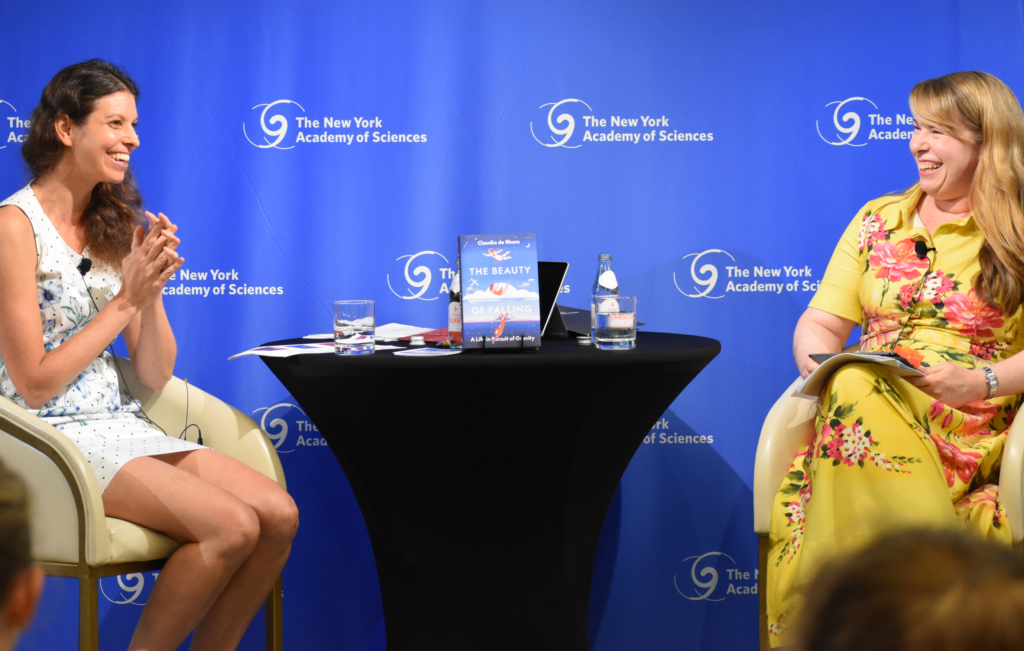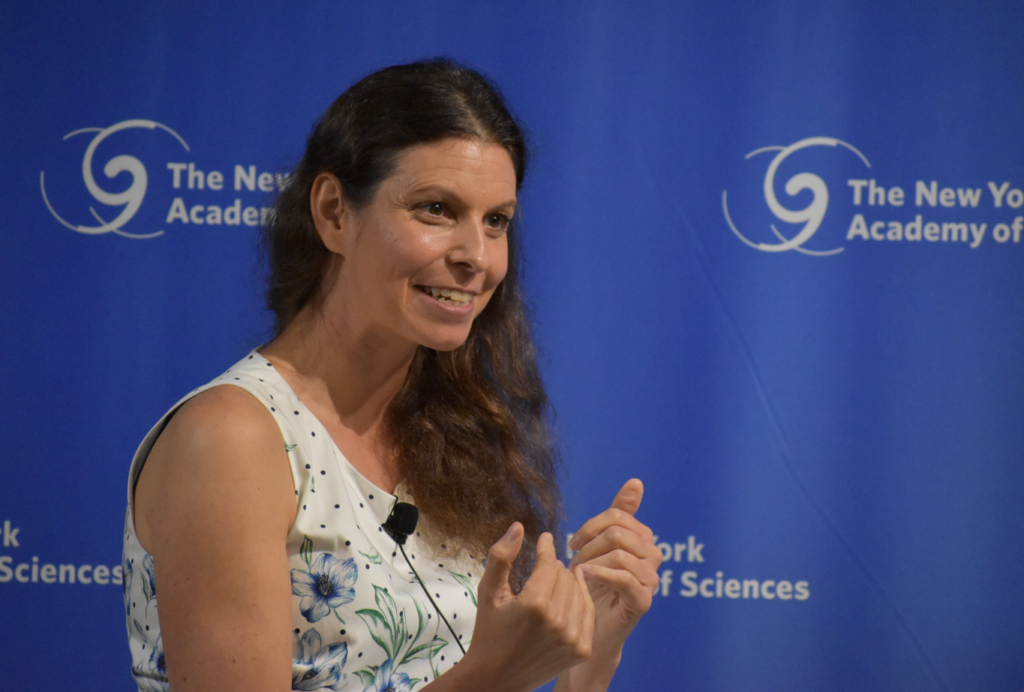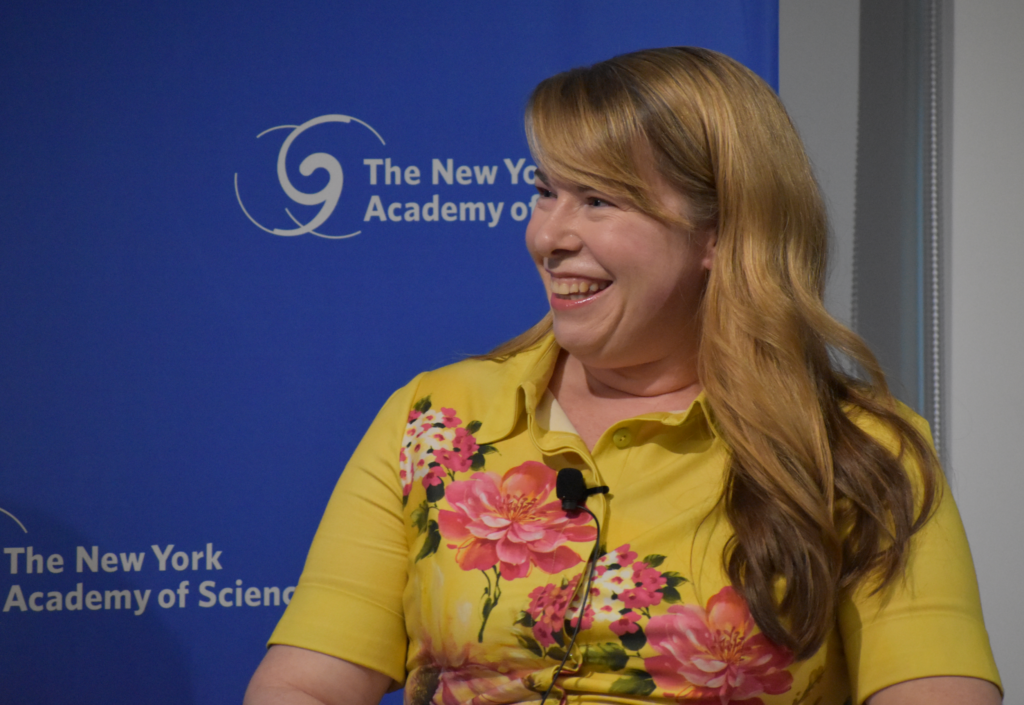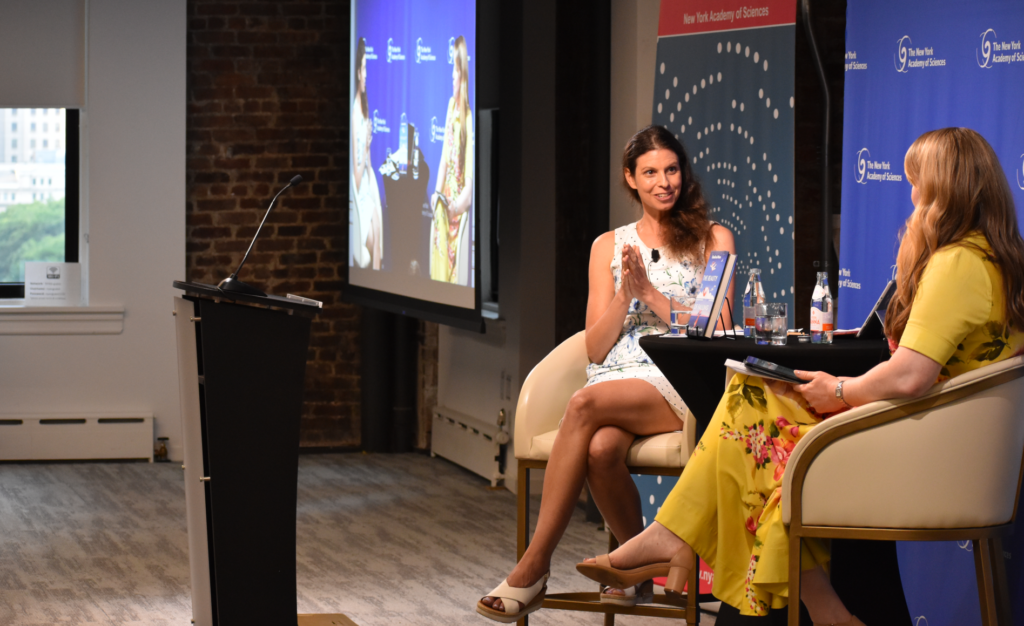A Life in Defiance of Gravity
New book explores blackholes, massive gravity, how Einstein was ahead of his time, and learning from failure.
Published July 31, 2024
By Nick Fetty
Digital Content Manager

Theoretical physicist Claudia de Rham discussed her recently published book, The Beauty of Falling: A Life in Pursuit of Gravity, during the recent Authors at the Academy Series, moderated by Chief Scientific Officer Brooke Grindlinger, PhD, at The New York Academy of Sciences.
A Life in Defiance of Gravity
Professor de Rham opened the conversation by joking that she’s had to “defy gravity for most of her life in an effort to understand it.” She observed her body’s buoyancy during diving expeditions in the Indian Ocean. She gazed at Canadian waterfalls from overhead while piloting aircraft. She even endured the rigors of astronaut training. All of this, coupled with her study of theoretical physics, helped to inform her book.
“We have this playful relationship with gravity, I think from an early age you can see that. Everybody likes to defy gravity, I don’t think I’m the only one,” de Rham said with a smile.
She recalled an impactful instance from her childhood in Peru when she went on an exhibition into the Amazon jungle. Lying in her hammock, she peered up at a clear, star-filled night sky and was enveloped with feelings of serenity and blissfulness. She thought philosophically about how humankind is just one part of the greater universe. She theorized that gravity was the throughline that connected humankind to nature, to other humans, to everything in the universe.
“From that point on I realized I really want to explore the fundamental laws of nature much more,” she said.
De Rham’s life and career has taken her across the globe. In addition to Peru, her childhood included stints in Switzerland and Madagascar. She earned degrees in France, Switzerland, and England, before taking a postdoc in Canada. She’s also served as faculty at institutions in Switzerland and the United States.
The Dream of Becoming an Astronaut

De Rham currently serves as a professor of theoretical physics at Imperial College London, where her work falls at the intersection of gravity, cosmology, and particle physics. While she is now an accomplished physicist, her initial goal was to become an astronaut.
“I [knew] well the chances were very limited” she said. “I was very realistic but still, if you have a dream, you should just go for it and see what happens.”
She spent more than two decades in her pursuit, despite there being no formal school or training regimen. She said that since the selection process occurs every 15-20 years, most people only get one shot in their lifetime. “There were 10,000 people who had the same thought as me, so I wasn’t the only one.”
The process involved completing the necessary medical, flight and other training. Those who made the next stage, then underwent psychological, psychometric, intelligence, and a “battery” of other evaluations over a one-year period.
She was among roughly 200 applicants who made it to the second round of evaluations which focused more on team bonding and responding to stress. She was then one of 42, and one of the few women, to make it to the next stage, which involved “all possible medical tests that you can imagine” on “every single part of your body.”
One Step Backward, Two Steps Forward
Ultimately, it was a positive result on a newly developed tuberculosis (TB) screening that led to her being declared ineligible. The doctor explained to her that because of a past infection, the test showed that she had the TB antibodies.
“So that was that. That was the end of the dream,” she said. “The dream is still there to some extent but also it changed shape.”
Even though she was disqualified for something beyond her control, she expressed no regrets about the time and effort she spent training.
“It’s not so much about the outcome at the end of the day, it’s about the journey and the experiences you have along the way,” she said.
She emphasized that the element of “potential failure” was important in the process because that’s how people learn and make progress. She quickly found that this approach to dealing with failure was applicable to her work as a scientist.
“As a theoretical physicist, when I fail, it’s just an equation that’s wrong, [and] I start over again,” she said. “To me it’s also part of this discovery with gravity where we know [the theory] does fail, and that’s actually something very positive because it tells us there is something to explore there.”
Einstein Was Right (Sort Of)
In 1915, Einstein proposed his theory of general relativity and within a year he used this theory to predict the existence of gravitational waves, ripples within space and time. His contemporaries rejected this new theory, and even Einstein second guessed himself, wondering if gravitational waves could be detected. Roughly 20 years later, he almost published a paper with the definitive and provocative title of “Do Gravitational Waves Exist? Answer: No!”

“He wasn’t satisfied not only by the fact that you couldn’t observe them but simply he wanted to claim that they were not part of reality, an illusion, a mathematical artifact,” said de Rham.
This paper was one of the first of his to undergo the peer review process. This involves fellow scientists from similar fields auditing research papers for scientific accuracy and feasibility.
Einstein did not take kindly to the referee of his paper who questioned his definitive declaration about the nonexistence of gravitational waves, however it did prod him to keep exploring. He eventually reworked his paper with the more accurate, less provocative title of “On Gravitational Waves.”
“There’s a lesson in there for all of the scientists who complain about the peer review process,” Dr. Grindlinger, the moderator, chimed in. “Even Einstein benefitted from peer review.”
In 2016, scientists from the National Science Foundation’s Laser Interferometer Gravitational-wave Observatory announced a significant breakthrough after directly detecting signals for gravitational waves in space – proving Einstein’s theory from a century prior.
The 2016 discovery involved earth-based instruments that were able to detect the gravitational waves of two merging blackholes in outer space. The ripples caused by this phenomenon traveled through space and time for millions of years until they were detected by the instruments on earth.
The Beginning of a New Era
Today’s consensus in theoretical physics suggests that Einstein’s theory of general relativity will eventually fail. One example being within Sagittarius A*, the supermassive blackhole at the center of the Milky Way galaxy.
“For the failure of Einstein’s theory of general relativity, we don’t need to have any observations to know directly where it would fail,” said de Rham. “And yet we know that we need to have a new theory that goes beyond Einstein’s theory of relativity to overcome it.”
To fill the gaps in the research, de Rham has developed her own theory of “Massive Gravity.” Though, much like Einstein, she at times second guesses her own idea.

“I’m not convinced that it’s a reality, but I am convinced that we should explore it,” said de Rham. “Because that’s how we learn.”
In 2011, de Rham, Gregory Gabadadze and Andrew Tolley developed a new, groundbreaking mathematical framework for the theory of massive gravity. Her work has profound implications for the area of research now dubbed “beyond Einstein gravity”, which includes exploring new types of particles in the universe and connecting the theories of gravity with current and next-generation astrophysics experiments.
“If gravity had a very small mass, then the messenger for gravity wouldn’t have as big of a reach anymore. That’s the idea behind the theory of massive gravity. You wouldn’t need to account for all the vacuum energy present in the whole of the universe to explain the accelerated expansion. You only account for a fraction of it and it leads to a smaller rate of acceleration of the universe,” said de Rham, succinctly summarizing her complex theory.
Award-Winning Research
In recognition of her breakthrough research, de Rham was named the 2020 Blavatnik Awards for Young Scientists in the United Kingdom Laureate in the Physical Sciences & Engineering category. The support from the award enabled her to continue conducting impactful research in this field, particularly new and innovative ideas that may not be supported by other funding agencies. The award is free of restrictions and is the largest of its kind for early career researchers.
“Science is always much more fun and creative than science fiction,” de Rham said in closing.
Check out the other events from our 2024 Authors at the Academy Series
- Reid Hoffman – Impromptu: Amplifying Our Humanity Through AI
- Erika Nesvold – Off-Earth: Ethical Questions and Quandaries for Living in Outer Space
- Venki Ramakrishnan – Why We Die: The New Science of Aging and the Quest for Immortality
- Arthuro Casadevall – What if Fungi Win?
Full video of these events is available, please visit nyas.org/ondemand
